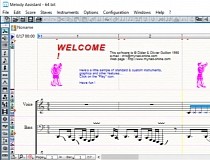


If you select this option, Melodyne will employ time-stretching (or -compression) to adjust the material already transferred to the new tempo. If you want Melodyne to stretch or compress the audio material to reflect the new tempo, check the box below. This tells Melodyne that the new tempo registered applies to the entire song and that it should adjust its own bar ruler accordingly. If you have simply changed the overall tempo and there are no tempo changes within the song itself, select Constant Tempo. Here you can inform Melodyne of the nature of the tempo change it has detected, in order to ensure that the two bar rulers remain in step. If you do nothing, you resign yourself to a discrepancy between the bar ruler in the DAW and that of Melodyne Plugin.Ĭlick the chain icon to open the tempo window. Whenever Melodyne registers a tempo change in the DAW, the chain icon near the tempo display will flash orange to indicate that a matter requires your attention.
Melody assistant not displaying bars correctly how to#
In this tour, you will find out how to do it. If, however, you have a tempo change in your DAW between two sections you have transferred to Melodyne or have altered the overall tempo in your DAW subsequently, you must inform Melodyne of such changes so that synchronicity between the bar rulers of the two applications can be restored. Normally Melodyne Plugin keeps step with your DAW, and the bar rulers and tempo displays of the DAW and Plugin show the same things. Important when working with variable tempo.


 0 kommentar(er)
0 kommentar(er)
